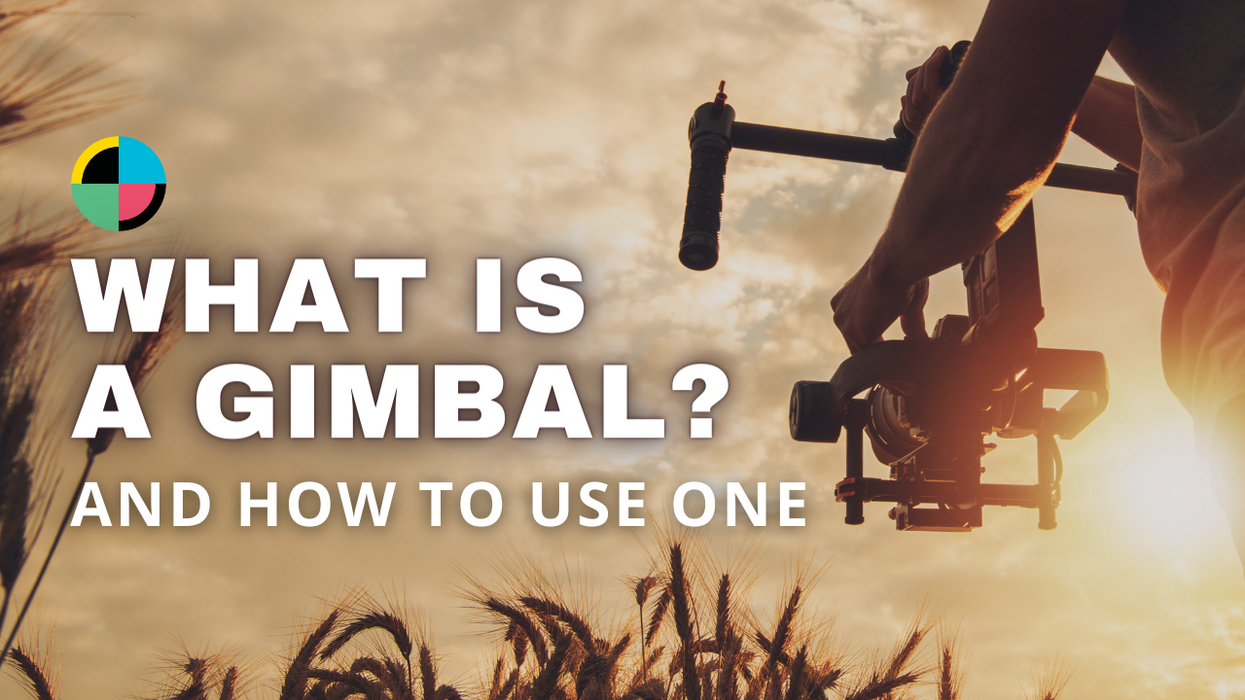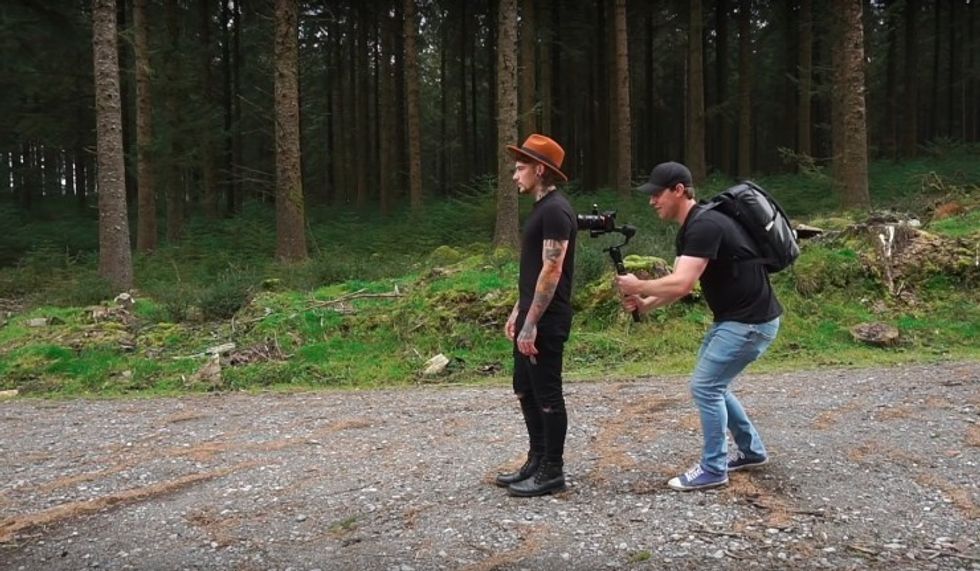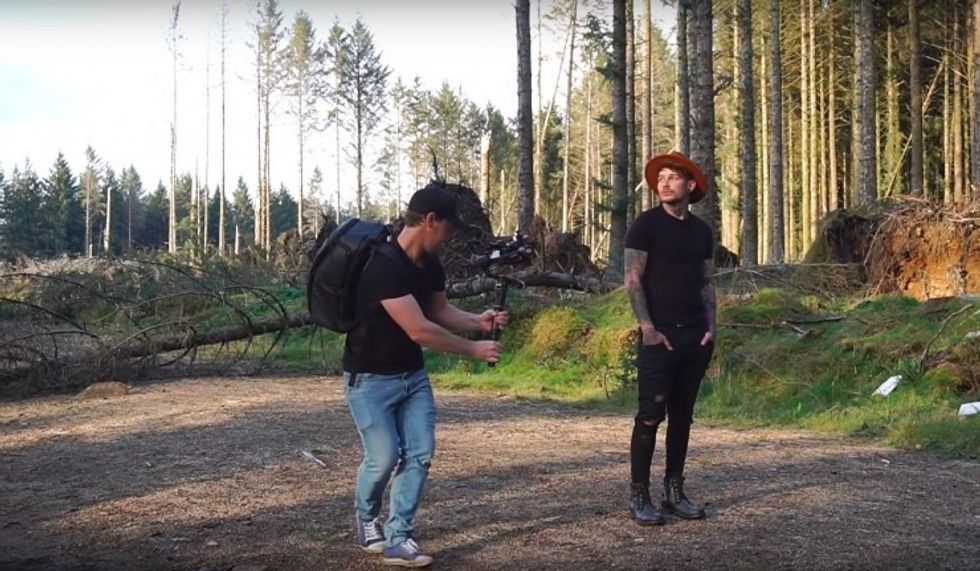What Is a Gimbal?
How can a gimbal help you stabilize your camera work?

Camera stability matters. Whether you're shooting a music video or TV episode or web series or a movie, when it comes to making sure your shots are on point, you might want to get a gimbal. But what is a gimbal? And why are so many cinematographers using them for their camera movements?
Today, our goal is to give you a base-level education into what a gimbal is and how you use one. We'll go over the definition and look at some tips for you to use on set. We'll also check out different ways you can use your gimbal to spice up your shot selection.
Sound good? Let's get started.
What Is a Gimbal? (Definition and How Do You Use One)
If you've been shooting long enough, you've heard the term "gimbal," but there's a high chance you may not know exactly what it is or what it can do. There are so many applications. You're going to want to know all this stuff.
Gimbal Definition
A gimbal is a pivoted support that allows for the rotation of an object about an axis. Most gimbals will either be two-axis or three-axis. The 3-axis is superior but much more expensive.
For cinematographers, handheld three-axis gimbals are used in stabilization systems. They are designed to give the camera operator the ability for handheld shooting but without the camera shake that comes with it.
Pitch, roll, and yaw—or tilt, roll, and pan
There are lots of terms when it comes to understanding how gimbals work. Some of them are the pitch, roll, or yaw axes. They refer to the points which allow the gimbal to stabilize. The pitch axis is also called the tilt axis. It’s the up-and-down movement of your camera.
The roll axis refers to the movement that feels like standing in a boat on the water.
Left-to-right movement happens around the yaw axis, or the pan axis. It’s used to capture objects that move horizontally, as in a panning shot or tracking shot.

How Does a Gimbal Work?
Gimbals work in tandem. They have three mounted circles with orthogonal pivot axes, which allows an object mounted on the innermost gimbal to remain independent of the rotation of its support, like a camera.
These moving pivots of the camera mount utilize quiet mechanical or brushless motors that make micro-adjustments to the arms so the footage you get is steady.
There are two versions of such stabilization systems—mechanical and motorized.
Mechanical Gimbals
Mechanical gimbals have a sled on top of the handle. A sled is a flat top stage where the camera is attached. They also have a post arm, which can be extended. The monitor and camera batteries counterbalance the camera weight.
It's the same basic principle of the Steadicam. The bottom is slightly heavier than the top, so the top stays stable. And in a gimbal, the top can pivot and have a range of motion thanks to the mechanical head that moves. This gimbal head allows for a wide range of motion.
Motorized Gimbals
Motorized gimbals are powered by three brushless motors. They can keep the camera level on all axes as the camera operator moves the camera.
So how do they work? Well, an inertial measurement unit (IMU) responds to movement and operates its three separate motors to stabilize the camera during aid movement.
The stabilizer can notice the difference between deliberate movement such as pans and tracking shots from unwanted shake.
That makes it very ideal for cinematographers since it is intuitive and not something they have to control themselves. These kinds of gimbals are also ideal for drones, where lots of movement can happen with little or no control from the ground.
How to Use a Gimbal
Not so long ago, epic cinematic shots were mainstays of jibs, cranes, and dollies. Now, a lone filmmaker with a few hundred bucks can pull off Hollywood-caliber movement—with one hand and a gimbal.
However, just buying a gimbal doesn’t equal good cinematography. You have to know how to use it, and how to communicate to your cast and crew what you are planning. Telling your actor that you’re doing the “Bad Boys 360-degree spin around thing” might work, but wouldn’t it be better if everyone had a more succinct working vocabulary?
Enter Steve Wright at Learn Online Video. Check out his video where he shows you 10 gimbal moves using the Zhiyun CRANE 2S that will make your footage look epic. And read our breakdown below.
What are Some Different Types of Gimbal Shots?
You saw the video above, now check out these very specific kinds of gimbal shots you can use at home or on set to make your footage more cinematic.
1. The Follow
The classic “follow your subject” shot.
Protip? Keep equal distance at all times to your subject, and for the most classic iteration, keep the subject in the center of the frame. You can experiment with lower angles to change the tone of the shot.

2. The Reverse Follow
Yup, just what you thought—tracking your subject from the front while walking backward.
Protip? Don’t trip!

3. Step In Reveal
Using some very minor choreography, this shot first introduces your location, then introduces your subject by having them enter the frame as you track.

4. Mini Jib Reveal
This is when you track backward, starting on your subject’s feet, and then lift to end on their face.
Who is this cool? By going from shoes to clothes to personal effects to the body to the face, it gives the audience a lot of information to learn who our subject is.

5. Side Track
This is actually trickier than the Follow and Reverse Follow, even though it is just tracking your subject from the side!
Protip—don’t walk sideways and follow your subject. It makes for some much more bumpy movement. Instead, frame your shot by turning the camera to the left or right, and walking straight forward.

6. Chest Transition
Ready to have some fun, and think about the edit while you shoot? Try this move that requires two shots.
For Shot 1, push forward until you are in the center of your subject's chest (here wearing a black shirt so the end frame is all black.)
Next, Shot 2 starts at your subject’s back as a black frame then moves backward as your subject moves forward. Cut between both at the moment in both where there is black frame.

7. Soft Focus Reveal
Frame your subject, lock focus on frame, then move backward. Start the shot as a wide and walk toward your subject until they are in focus.
Instant intrigue!
8. Wipe Transition
Here’s another one that involves cutting two shots together in editing for a cool combined effect. This involves two shots where you track from the side and use something in the foreground to wipe.
In Shot 1, you track from the side to wipe past the camera. (Make sure it is something unidentified and blurry, as Wright explains.)
Then Shot 2 starts at something equally unidentified and blurry, and moves past it to find your subject again. Edit together with a simple cut to create an interesting but invisible shift in direction for the audience.

9. The Orbit
Walk around your subject in a circle, Michael Bay style.
Protip—consider what focal length you want for your type of orbit. The wider your shot, the more environment. Angle up and you get something a little more dramatic.

10. The Fake Drone
One of Wright’s favorite shots looks like it's been done with a drone. No props required!
To pull it off, you start close to your subject at a wide focal length. Then, as you steadily walk backward, raise your gimbal up as high as it will go.

Summing Up "What Is a Gimbal?"
Now that you know all about gimbals, it's time to assemble your own kit and start practicing your intentional movements. Capturing moving subjects has always been a little tricky but that's when a gimbal works best. Its camera mounts are crucial to stabilization (eliminating camera shake), canceling out unwanted movement.
Whether you're using motorized motion detecting with brushless motors or a mechanical gimbal, tracking shots will never be the same.
So go grab your DSLR camera or whatever you use and get shooting smooth footage with pivoted support!
We can't wait to see what you do out there.
Check out weekly specials, deals, and rebates: Pro Video Gear, Pro Audio Gear, Lighting











